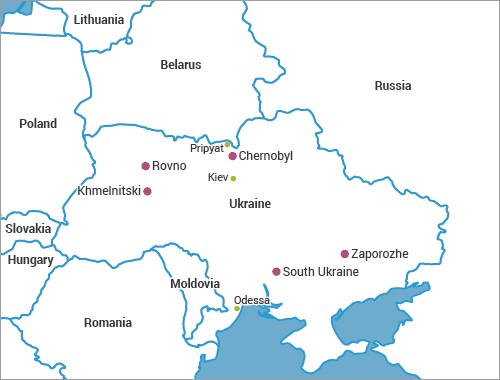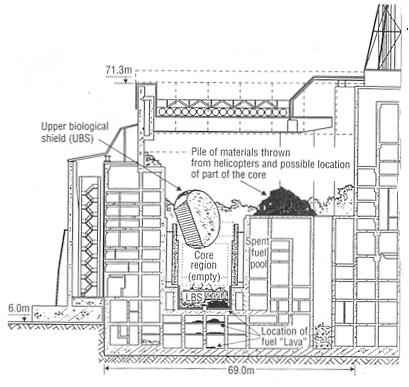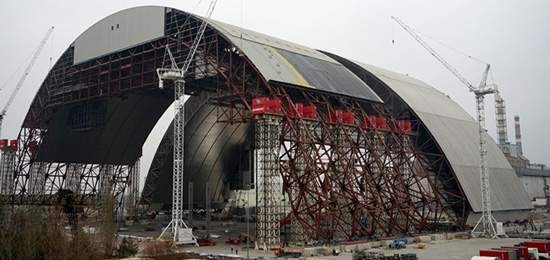What Is Chernobyl? The Chernobyl disaster was a catastrophic nuclear accident that occurred in April 1986 at the Chernobyl Nuclear Power Plant in Ukraine, then part of the Soviet Union, and understanding its complexities is crucial. At WHAT.EDU.VN, we provide clear, accessible explanations to help you grasp such complex topics, ensuring you get the answers you need quickly and easily. Explore the Chernobyl disaster, its causes, consequences, and long-term impacts, with a focus on Chernobyl’s exclusion zone, nuclear safety, and radiation exposure effects.
1. Understanding the Chernobyl Disaster: An Overview
The Chernobyl disaster, a pivotal event in nuclear history, unfolded on April 26, 1986, at the Chernobyl Nuclear Power Plant, near Pripyat, Ukraine. It was triggered by a flawed reactor design and human error during a safety test, leading to a steam explosion and a subsequent reactor meltdown. This incident is considered the most severe nuclear accident in history, both in terms of cost and casualties.
The event resulted in the immediate deaths of two plant workers due to the explosion. In the weeks that followed, 28 more people died from acute radiation syndrome (ARS). The accident released substantial amounts of radioactive materials into the atmosphere, contaminating vast areas across Ukraine, Belarus, Russia, and other parts of Europe. Approximately 350,000 people were evacuated from the affected regions, leading to long-term social and economic disruption. While the immediate impact was devastating, the long-term health consequences and environmental effects continue to be studied and debated. The Chernobyl disaster prompted significant changes in nuclear safety protocols and international cooperation in nuclear energy.
Location of Chernobyl and other nuclear power plants in Ukraine
2. Causes of the Chernobyl Accident: Design Flaws and Human Error
The Chernobyl accident was a result of a combination of factors, including inherent design flaws in the RBMK-1000 reactor and significant human errors during a poorly designed safety test. The RBMK reactor had a positive void coefficient, which meant that as steam bubbles formed in the cooling water, the reactor’s power output increased, leading to instability. This design flaw was not widely known among the plant operators.
On the night of the accident, the operators were conducting a test to see how long the turbines would spin and supply power to the main circulating pumps following a loss of external electrical power. During the test, a series of operator errors, including disabling automatic shutdown mechanisms and allowing the reactor power to drop too low, created an extremely unstable condition. When the operators attempted to shut down the reactor, the design of the control rods caused a power surge, leading to a steam explosion that destroyed the reactor. The subsequent fires released a large amount of radioactive material into the atmosphere.
3. Immediate Impact: Casualties and Initial Response
The immediate aftermath of the Chernobyl disaster was marked by chaos and a desperate effort to contain the situation. Two workers died in the initial explosion, and within weeks, 28 more succumbed to acute radiation syndrome (ARS). These were primarily firefighters and plant personnel who received extremely high doses of radiation while trying to control the fires and stabilize the reactor.
The initial response involved evacuating the nearby city of Pripyat, which had a population of around 49,000. By May 14, 1986, approximately 116,000 people within a 30-kilometer radius had been evacuated. The evacuated areas became known as the Chernobyl Exclusion Zone.
The damaged Chernobyl unit 4 reactor building
4. Radioactive Release: Scale and Composition
The Chernobyl accident resulted in the largest uncontrolled radioactive release into the environment ever recorded for any civilian operation. It is estimated that all of the xenon gas, about half of the iodine and caesium, and at least 5% of the remaining radioactive material in the Chernobyl 4 reactor core were released. This included approximately 14 EBq (14 x 1018 Bq) of radioactivity, with a significant portion consisting of biologically inert noble gases.
The released material was dispersed widely, with heavier particles deposited close to the plant and lighter materials carried by wind over Ukraine, Belarus, Russia, Scandinavia, and other parts of Europe. The primary radionuclides of concern were short-lived iodine-131 and long-lived caesium-137, which posed significant health risks due to their ability to accumulate in the environment and the food chain.
5. Health Effects: Acute Radiation Syndrome (ARS) and Long-Term Impacts
The health effects of the Chernobyl disaster are complex and have been studied extensively. Acute Radiation Syndrome (ARS) was diagnosed in 134 emergency workers and plant personnel, resulting in 28 deaths within a few weeks. ARS occurs when a person is exposed to high doses of radiation within a short time frame, leading to symptoms such as nausea, vomiting, headaches, burns, and fever.
Long-term health effects have been a subject of considerable debate. The United Nations Scientific Committee on the Effects of Atomic Radiation (UNSCEAR) and the World Health Organization (WHO) have conducted numerous studies. One of the most significant findings is a substantial increase in thyroid cancer among individuals who were children and adolescents at the time of the accident. However, apart from thyroid cancer, there is no clear evidence of a major increase in overall cancer incidence or mortality directly attributable to radiation exposure. Mental health issues, including anxiety and depression, have also been observed in affected populations.
6. The Chernobyl Exclusion Zone: Current Status and Future Prospects
The Chernobyl Exclusion Zone is a 30-kilometer radius area around the Chernobyl Nuclear Power Plant that was established after the disaster. It was initially evacuated to protect the public from radiation exposure, and access remains restricted to this day. The zone is monitored for radiation levels, and some areas are still heavily contaminated.
Despite the dangers, the Exclusion Zone has become an unexpected haven for wildlife. With the absence of human activity, populations of various animal species, including wolves, deer, and birds, have thrived. The area has also become a site for scientific research, focusing on the effects of radiation on the environment and the potential for remediation.
Efforts are underway to manage radioactive waste and decommission the remaining reactors at Chernobyl. The New Safe Confinement (NSC), a massive arch-shaped structure, was completed in 2017 to cover the damaged reactor and prevent further release of radioactive materials. The NSC is designed to last for 100 years and will allow for the eventual dismantling of the reactor and the removal of radioactive waste.
Chernobyl New Safe Confinement under construction and before being moved into place (Image: EBRD)
7. Nuclear Safety Lessons: Changes and Improvements Post-Chernobyl
The Chernobyl disaster prompted a major reassessment of nuclear safety practices worldwide. Significant changes were implemented to prevent similar accidents from occurring in the future.
One of the key changes was increased international cooperation in nuclear safety. Organizations like the World Association of Nuclear Operators (WANO) were formed to promote the exchange of information and best practices among nuclear power plant operators. Safety standards were strengthened, and more rigorous inspections and oversight were implemented.
Specific improvements were made to reactor designs, particularly in Soviet-designed RBMK reactors. These included modifications to control rods, enhanced emergency shutdown systems, and better containment structures. Additionally, there was a greater emphasis on safety culture, ensuring that plant operators were well-trained and had a strong understanding of the risks involved.
8. Chernobyl and Tourism: Exploring the Exclusion Zone
In recent years, Chernobyl has become an increasingly popular tourist destination. Visitors can take guided tours of the Exclusion Zone, including the abandoned city of Pripyat and the Chernobyl Nuclear Power Plant. These tours provide a unique and eerie glimpse into the aftermath of the disaster.
Tour operators emphasize safety, and visitors are required to follow strict guidelines to minimize radiation exposure. While there are still risks associated with visiting the Exclusion Zone, the levels of radiation in many areas are relatively low, and the experience can be both educational and thought-provoking.
9. Misconceptions about Chernobyl: Separating Fact from Fiction
Despite extensive scientific research, many misconceptions about the Chernobyl disaster persist. Some of the most common myths include exaggerated death tolls and widespread genetic mutations.
While the accident did have significant health consequences, the actual number of deaths directly attributable to radiation exposure is much lower than often reported. Additionally, while radiation can cause genetic mutations, there is no evidence of widespread genetic abnormalities in the populations affected by Chernobyl.
It is important to rely on credible sources of information, such as reports from UNSCEAR, WHO, and the IAEA, to understand the true impact of the disaster and avoid perpetuating misinformation.
10. Current Research: Understanding the Long-Term Effects of Chernobyl
Ongoing research continues to shed light on the long-term effects of the Chernobyl disaster. Scientists are studying the health of individuals who were exposed to radiation, as well as the environmental impact on the Exclusion Zone.
Studies are examining the prevalence of various diseases, including cancer and cardiovascular disease, in affected populations. Researchers are also investigating the unique ecosystem that has developed in the Exclusion Zone, including the adaptation of plants and animals to radiation. This research is crucial for understanding the long-term consequences of nuclear accidents and for developing strategies to mitigate their impact.
11. Chernobyl’s Legacy: What We Can Learn from the Disaster
The Chernobyl disaster is a stark reminder of the potential consequences of nuclear accidents. It underscores the importance of robust safety measures, international cooperation, and a strong safety culture in the nuclear industry.
Chernobyl also highlights the need for transparency and accurate communication in the event of a nuclear emergency. Misinformation and lack of trust can exacerbate the impact of a disaster and hinder effective response efforts. By learning from the mistakes of the past, we can work to prevent similar tragedies from occurring in the future.
12. The Future of Nuclear Energy: Balancing Risks and Benefits
The Chernobyl disaster has had a profound impact on the development of nuclear energy. While some argue that nuclear power is too dangerous and should be abandoned, others believe that it is a necessary source of low-carbon energy that can help combat climate change.
The future of nuclear energy will likely depend on the ability to address safety concerns and improve public trust. This includes developing safer reactor designs, implementing robust safety protocols, and ensuring that nuclear waste is managed responsibly. As the world seeks to transition to a cleaner energy future, nuclear power may play a role, but only if it can be done safely and sustainably.
13. Chernobyl’s Impact on the Arts and Culture
The Chernobyl disaster has had a significant impact on the arts and culture, inspiring numerous books, films, and documentaries. These works explore the human stories behind the disaster, the environmental consequences, and the political and social implications.
Some notable examples include the HBO miniseries “Chernobyl,” which received critical acclaim for its portrayal of the events leading up to and following the accident. Books such as “Voices from Chernobyl” by Svetlana Alexievich offer personal accounts from individuals affected by the disaster. These artistic works help to keep the memory of Chernobyl alive and to remind us of the importance of learning from the past.
14. Frequently Asked Questions (FAQs) about Chernobyl
Here are some frequently asked questions about Chernobyl, providing concise answers to common queries:
| Question | Answer |
|---|---|
| What caused the Chernobyl disaster? | A flawed reactor design and human error during a safety test. |
| How many people died in the immediate aftermath? | Two plant workers died in the explosion, and 28 more died from acute radiation syndrome within weeks. |
| What is the Chernobyl Exclusion Zone? | A 30-kilometer radius area around the Chernobyl Nuclear Power Plant evacuated after the disaster and restricted to access. |
| Is it safe to visit Chernobyl? | Guided tours are available, but visitors must follow strict safety guidelines to minimize radiation exposure. |
| What are the long-term health effects? | Increased risk of thyroid cancer, particularly among those who were children at the time of the accident. Other health effects are still being studied. |
| What is the New Safe Confinement? | A massive arch-shaped structure built to cover the damaged reactor and prevent further release of radioactive materials. |
| How has Chernobyl affected wildlife? | The absence of human activity has allowed populations of various animal species to thrive in the Exclusion Zone. |
| What lessons have been learned from Chernobyl? | The importance of robust safety measures, international cooperation, transparency, and a strong safety culture in the nuclear industry. |
| What is the future of nuclear energy? | Dependent on addressing safety concerns, improving public trust, and developing safer reactor designs. |
| Where can I get accurate information about Chernobyl? | Reputable scientific reports from UNSCEAR, WHO, and IAEA, as well as documentaries and books based on thorough research. |



15. Call to Action: Learn More and Ask Questions at WHAT.EDU.VN
Do you have more questions about Chernobyl or any other topic? At WHAT.EDU.VN, we are committed to providing you with clear, accurate, and accessible information. Whether you are a student, a professional, or simply curious about the world around you, we are here to help.
Don’t hesitate to visit our website and ask your questions. Our team of experts is ready to provide you with the answers you need, quickly and easily. Join our community of learners and discover the power of knowledge with WHAT.EDU.VN.
Contact Us:
- Address: 888 Question City Plaza, Seattle, WA 98101, United States
- WhatsApp: +1 (206) 555-7890
- Website: WHAT.EDU.VN
Let what.edu.vn be your trusted source for answers and information. We look forward to helping you explore the world and expand your understanding.